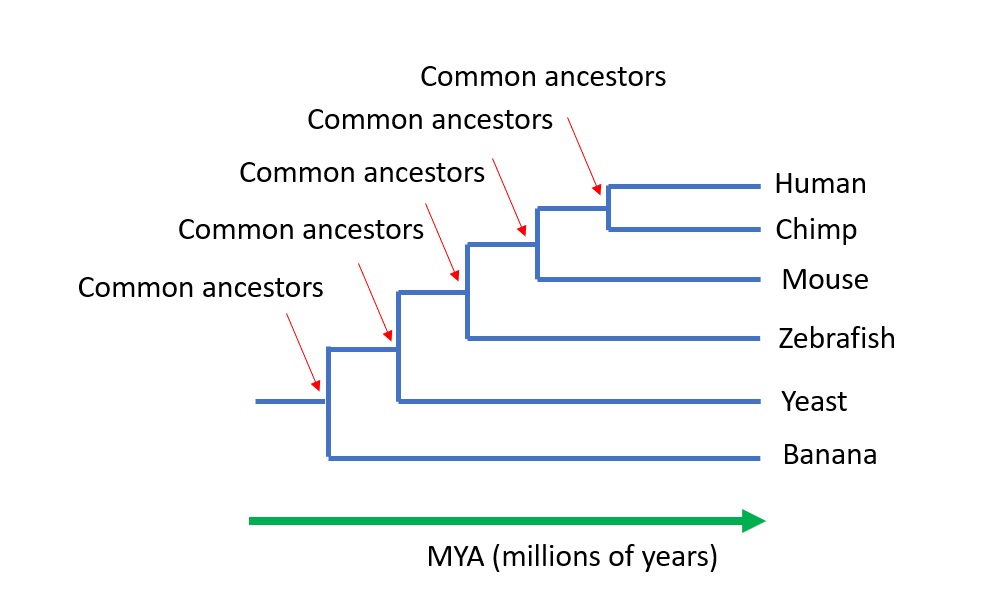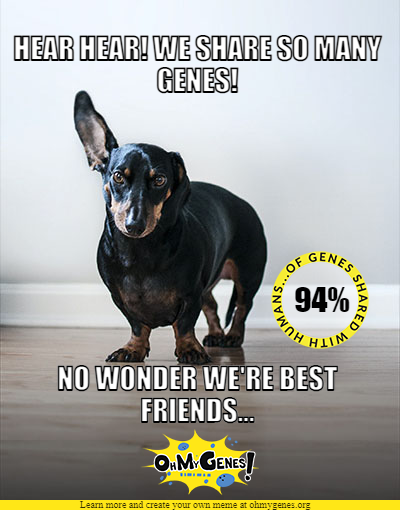Duration of the activity: 30 minutes
Recommended age: 11 years old and onwards
Material: marbles of different colours (minimum of 9 different colours), 7 jars and a calculator.
Comparative genomicsQuest for orthologs
Banana split
- Your turn to play
The quest for marbles!
Context
The goal of this activity is to discover the concepts related to comparative genomics and, specifically, the quest for orthologs.
By the end of this activity, you will also understand how the OhMyGenes.org web site allows you to determine the % of genes in common between species of your choosing…and thus create fun memes.
Helpful info
Orthologs can be thought of as the ‘same’ gene in different species. Please review the following topics and story in order to familiarise yourself with orthologs and how we can use them:
A BIT OF EVOLUTION > Orthology: an important concept
Activity 1. Principle
Each species has its jar. The different genes for each species are represented by marbles. The number of marbles is proportional to the number of genes in each species: each marble corresponds to about 1,000 genes. The genes specific to each species are represented by the white marbles. The orthologous genes, which are common to the 2 species, are represented by coloured marbles.
Aim: calculate the number of orthologous genes.
Let’s compare humans to bananas.
Humans have ~ 20,430 genes (20 marbles), of which ~4,963 (5 yellow marbles) are orthologous to the banana.
The banana has ~36,439 genes (36 marbles), of which ~9,518 (9 yellow marbles) are orthologous to humans.
The total number of genes and the total number of genes in common (orthologs) are proportional to the real data.
Questions
- What % of the genes in humans are orthologous to those of the banana?
- What % of the genes in the banana are orthologous to those of humans?
Answer and explanations…
Humans: 5 marbles / 20 = 25% of human genes are orthologous to those of the banana.
Banana: 9 marbles / 36 = 25% of banana genes are orthologous to those of humans.
OhMyGenes.org takes the average of these 2 percentages which, depending on the species being compared, may differ.
Note: One could have expected to have the same number of yellow marbles in the 2 jars. But, due to gene duplication, the same gene may be present in multiple copies in another species and vice versa. For example, the gene TUBB8 is found as a single copy in humans, but there are 18 ‘orthologous’ copies in the genome of the banana.
Let’s compare human to yeast…
The yeast (Saccharomyces cerevisiae) is a unicellular fungus which is best known for its use in making bread, wine or beer.
Humans have ~ 20,430 genes (20 marbles), of which ~6,762 (7 blue marbles) are orthologous to those of yeast.
Yeast has ~6,352 genes (6 marbles), of which ~2,633 (3 blue marbles) are orthologous to those of humans.
The total number of genes and the total number of genes in common (orthologs) are proportional to the real data.
Questions
- What % of the genes in humans are orthologous to those of yeast?
- What % of the genes in yeast are orthologous to those of humans?
Answer and explanations…
Humans: 7 marbles / 20 = ~35% of human genes are orthologous to those of yeast.
Yeast: 3 marbles / 6 = 50% of yeast genes are orthologous to those of humans.
OhMyGenes.org takes the average of these 2 percentages: ~40% (37.3% if we take the ‘exact values’).
Note: Yeasts (fungus) are closer to humans than plants from an evolutionary perspective: the ancestor common to humans and yeast lived ‘more recently’ than that of humans and the banana!
According to the web site www.timetree.org (node time), the ancestor common to humans (Homo sapiens) and yeast (Saccharomyces cerevisiae) lived approximately 1,105 MYA (millions of years ago), whereas the ancestor common to humans and the banana (Musa acuminata), lived approximately 1,496 MYA!
Activity 2. Compare the species of your choice…
and create the most original meme at Oh My Genes!
What percentage of genes do we have in common with the dog, the cat, the tomato or the dolphin?
Lead the investigation…and once you have the % of genes orthologous between humans and the different species, try to represent your results in a tree similar to this one:

Examples of data
Percentage of genes orthologous to those of humans
| Dog | Cat | Mosquito | Yeast | Chicken | Dolphin | Chimpanzee | Fruit fly | Seahorse |
| 94.4% | 94.3% | 45.7% | 37.5% | 83.8% | 95.6% | 97.8% | 45.2% | 74.8% |
Activity 3. Let’s compare 5 different species…
Let’s take our example again, but this time with 5 species: E.coli (a bacteria), fruit fly, banana, humans and mice.
Each marble represents 1000 genes. The total number of genes and the total number of genes in common (orthologs) are proportional to the real data.
The different coloured marbles represent genes that are common to different groups of species or that are specific to a single species.
Questions
- Which species has the highest number of genes?
- Which species has the least number of genes?
- If each marble represents ~1000 genes, how many genes are there in the human genome?
- How many genes are common to all these species?
– What is the name given to the last common ancestor of all species?
– Can you imagine some ‘universal’ common biological functions? - What is the percentage of genes specific to humans (primates)?
- To which large group(s) of species could the blue marbles, the green marbles and the purple marbles belong?
- What percentage of genes do humans and bananas and bananas and humans have in common?
- Which species are the most similar in terms of number of genes in common (orthologs)?
– What are the implications for scientific research? - Build a phylogenetic tree based on the number of genes in common (orthologs).
Answers & Explanations
- The banana is the species with the highest number of genes.
- Bacteria is the species with the lowest number of genes.
- The human genome contains about 20,000 genes (20,430 according to OMA)
- 1 red marble, or about 1,000 genes are common to all these species.
– The name given to the common ancestor of all organisms is LUCA (Last Unique Common Ancestor).
– The universal biological functions are for example: protein synthesis, DNA replication, energy production,… - About 1,000 genes / 20,000 (5%) are specific to humans (primates). These genes code, for example, for proteins involved in the development of neurons.
- The blue marbles represent genes common to mammals; the green marbles, genes common to bilaterians (organisms with left-right symmetry); the purple marbles, genes common to eukaryotes.
- 5 / 20 marbles (25%) for human; 10 / 37 marbles (27%) for banana.
- Humans and mouse are the most similar species in terms of the number of genes in common (orthologs): between 90 and 95% of orthologous genes.
– The mouse is a model animal that is often used for biomedical research, such as for the search for new drugs. - Phylogenetic tree:

Examples of genes and biological function common to different groups of species
| Level | Bacteria (E.coli) | Banana | Fruit Fly |
Humans | Mouse | Biological function |
| LUCA | rplE | N/A | RL11 | RL11 | RL11 | protein synthesis (ribosomal protein) |
| LUCA | groL | N/A | Hsp60B | CCT2 | CCT2 | protein folding (chaperon) |
| LUCA | sucC | 103994981 | ScsbetaG | Sucla2 | Sucla2 | energy production (ATP) |
| Eucaryota | – | N/A | SMU1 | SMU1 | SMU1 | mRNA matutation (splicing) |
| Eucaryota | – | N/A | mei-W68 | Gos28 | Gos28 | protein transport within organelles |
| Mammals | – | – | – | SPATA31E1 | Gm30302 | sperm production |
| Mammals | – | – | – | IGKV2-24 | Gm20730 | antibody |
| Insects | – | – | Acp36DE | – | – | involved in behavioral changes in mated female flies |
| Insects | – | – | Or33b | – | – | odorant receptor |
| Primates | – | – | – | NPW | – | neuropeptide involved in the stimulation of water drinking and food intake. |
Note: Gene names may be different from one species to another or not yet assigned (N/A).
To learn more about these genes and the corresponding proteins, click on the links that will bring you to the UniProtKB database.

